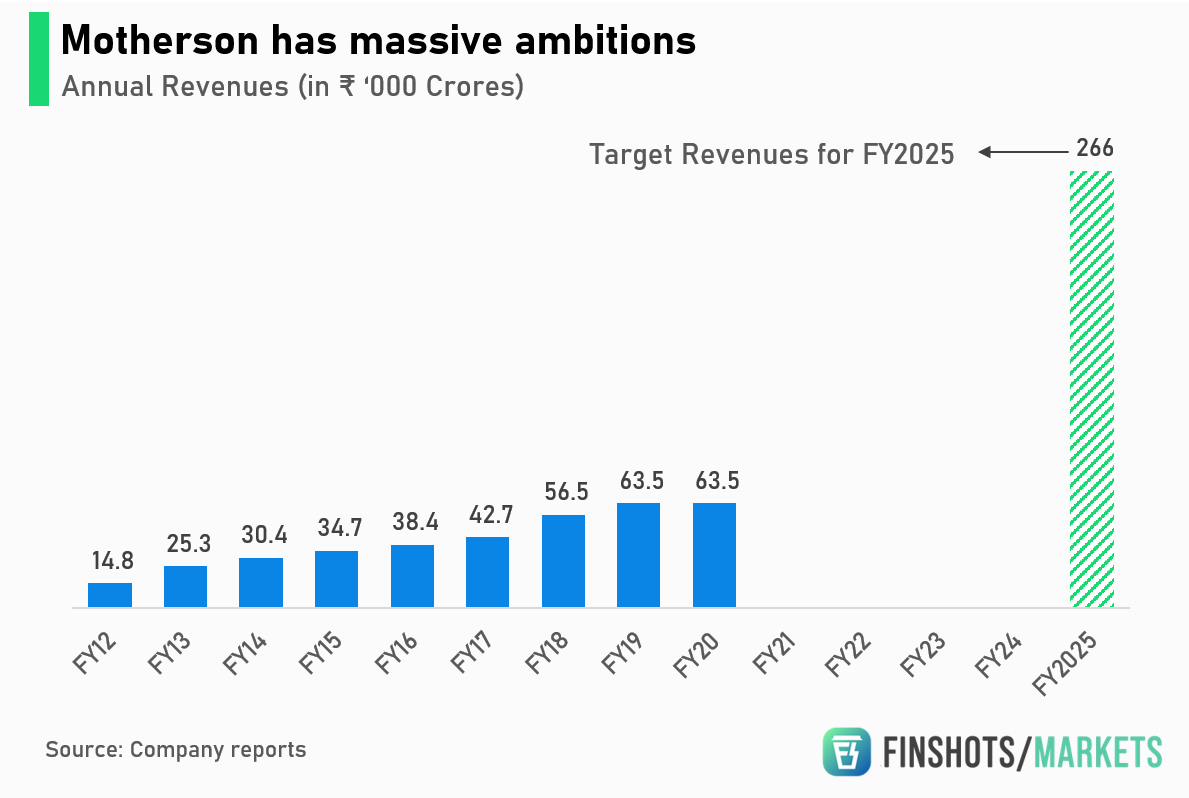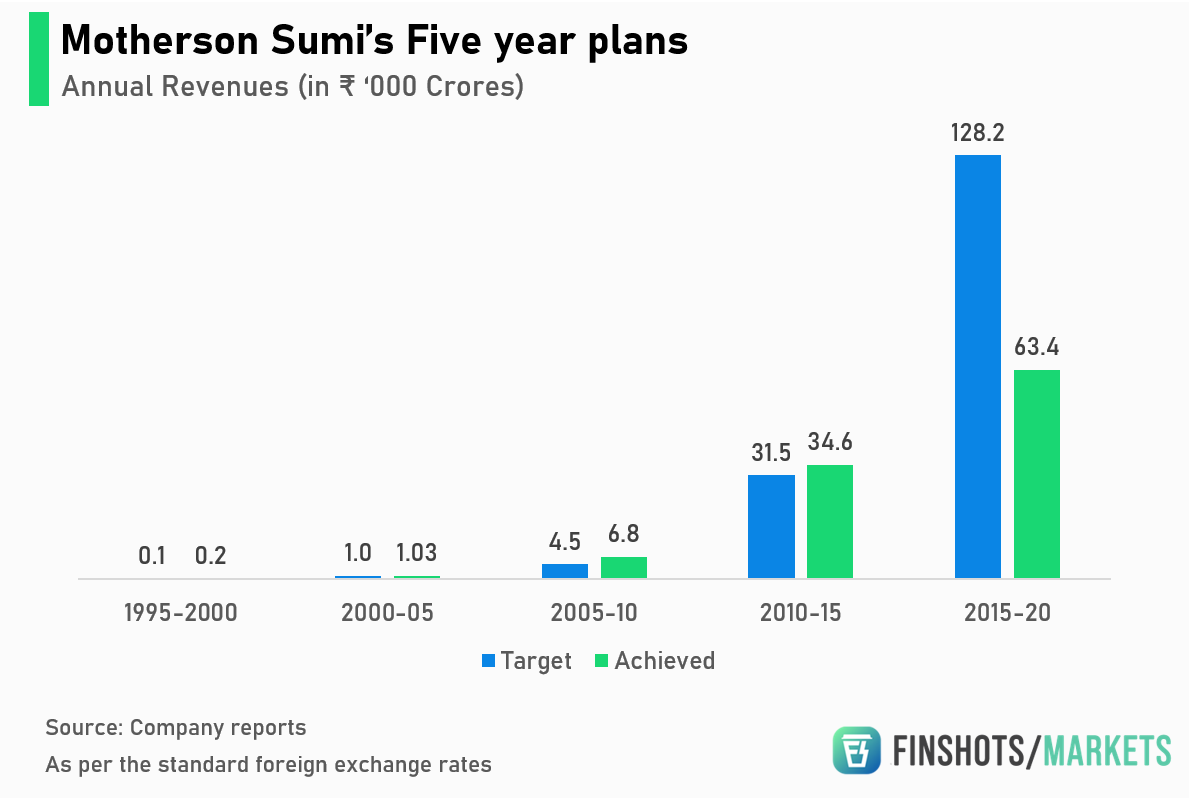Last week, Motherson Sumi unveiled its detailed 5-year plan where it set an ambitious target of reaching sales figures totalling ₹2.6 lakh Cr by 2025. That means they’ll have to quadruple sales over the next five years. And while such lofty proclamations are usually met with derision, investors and analysts have been quite optimistic about the company’s prospects. In fact, its stock price made a yearly high right after the announcement.
So we have to look at this more closely and ask — Do these claims warrant serious consideration or are they mostly fluff? Well, in today’s Finshots Markets, we will discuss this and more.
The Story
Motherson Sumi Systems Limited (MSSL) is the largest auto component manufacturer in India. In fact, it's one of the biggest companies worldwide in this line of business. But this isn’t some overnight success story here. Their history spans decades. In fact, the company embarked on its journey all the way back in 1983, when it started manufacturing wiring harness system for Maruti (now Maruti Suzuki). Think of these as complex wires and wiring components that run through the entire vehicle connecting all the parts together. And in a bid to do the best job possible, the company joined hands with the Japanese entity Sumitomo Wiring Systems and Motherson Sumi was established as a joint venture soon after.
And today MSSL is one of the biggest wiring harness companies in the world. Its revenue figures stand at ~₹63,000 Cr and its operations span 41 countries, with 270 production facilities and 1.35 lakh employees worldwide.
But Motherson Sumi’s growth strategy is a bit unique. You see, they don’t rely a lot on organic growth. Instead, they’ve been pinning their hopes on acquisitions. So far, they’ve made 21 acquisitions in total. And they don’t just acquire any company. Oh no! They buy out companies that are on the verge of collapse and then turn them around.
In the year 2002, the company made its first acquisition by taking over an Ireland based bankrupt wiring harness manufacturer, Wexford Electronics. In 2008, they acquired UK-Based Visiocorp, a company that manufactured rear-view mirrors for most of the global automakers. In 2011, they bought a distressed German company, Peguform that supplied bumper systems, dashboards, and vehicle cockpits for the likes of Volkswagen, BMW, Daimler, and Porsche.
And there’s one common theme with most of these acquisitions. They almost always came at a bargain price. For instance, they paid ₹163 Cr for Visiocorp at the height of the financial crisis. Today, it’s one of the largest manufacturers of rearview mirrors in the world. Its revenue has risen from ₹4,100 Cr to ₹12,400 Cr in the past decade and it contributes roughly 20% of the total revenue and 30% of the operating profit. Meanwhile, after a decade of acquiring Peguform for a mere ₹890 Cr, the company’s revenue touched ₹32,000 Cr in 2020 accounting for 50% of Motherson Sumi’s revenue and 24% of its operating profit
These are truly remarkable numbers.
But Motherson Sumi’s future plans are as audacious as its previous acquisitions. In fact, they lay out a five year plan outlining their ambition and somehow they’ve been meeting these targets for more than two decades now. Except the most recent plan outlined between 2015-20. We will get to that bit in a minute. But as it stands, Motherson Sumi wants to quadruple its sales to ₹2.6 lakh crores over the next five years. And they also want to make sure that no customer, component, or country contributes more than 10% to their top line.

All great stuff.
But how do they get there?
Well according to the company, most of this growth will come from their existing automotive business. With the wiring harness division, the company plans to enter untapped geographies and also tend to products beyond passenger vehicles. Think 2-wheelers, commercial vehicles and even off-highway vehicles. And with the mirrors, maybe look at manufacturing more complicated components, including camera monitoring systems that are quite expensive. With the polymer products i.e. the bumpers and stuff the company is planning to enter new markets like Eastern Europe, China, and Africa whilst also offering more value-added products including sensors.
Also, the company plans to venture beyond automotives and try their hand at aerospace and health-tech markets as well. So if they’ve got such high ambitions and a stellar track record what went wrong during the last 5-year plan you ask? After all, they had plans to hit revenues of roughly ₹1.2 lakh crores. So how come they only managed to do half those numbers?
Well, the company hasn’t fully outlined this bit yet. But that hasn’t stopped people from speculating. For starters, when the plan was originally laid out, the company was pinning its hopes on the European markets. But then, Brexit induced business uncertainties forced the management to reassess their plans altogether. Also, the domestic auto market hasn’t been kind to anybody in the last couple years. And the pandemic has only further exacerbated some of these concerns.

So if Motherson Sumi is to realise its target, then it's safe to say, they need the external business environment to change and to change quickly.
But they still have the final trump card — acquisitions. If the company can continue to find “value-for-money” businesses and turn them around, you really can’t put past anything beyond Motherson Sumi. In fact, just this October, the company acquired the wiring business of Bombardier Transportation in Mexico. Remember this was happening right in the middle of a pandemic. And who knows? Maybe this might even offer them opportunities that would otherwise never have materialized.
So the target is set — ₹2.6 lakh crores in sales.
Will they be able to hit it? Or is it too steep?
Let us know your thoughts on Twitter.
Until then…
Share this Finshots Markets on WhatsApp or Twitter.
The Right to Repair
Also, have you ever wondered why it’s so hard to repair your products these days? Well, there’s a good reason why it’s happening and no, it’s not because you are going crazy. Read more about this interesting story from one of our Finshots Daily articles
Why the Right to Repair movement is taking over the world?

